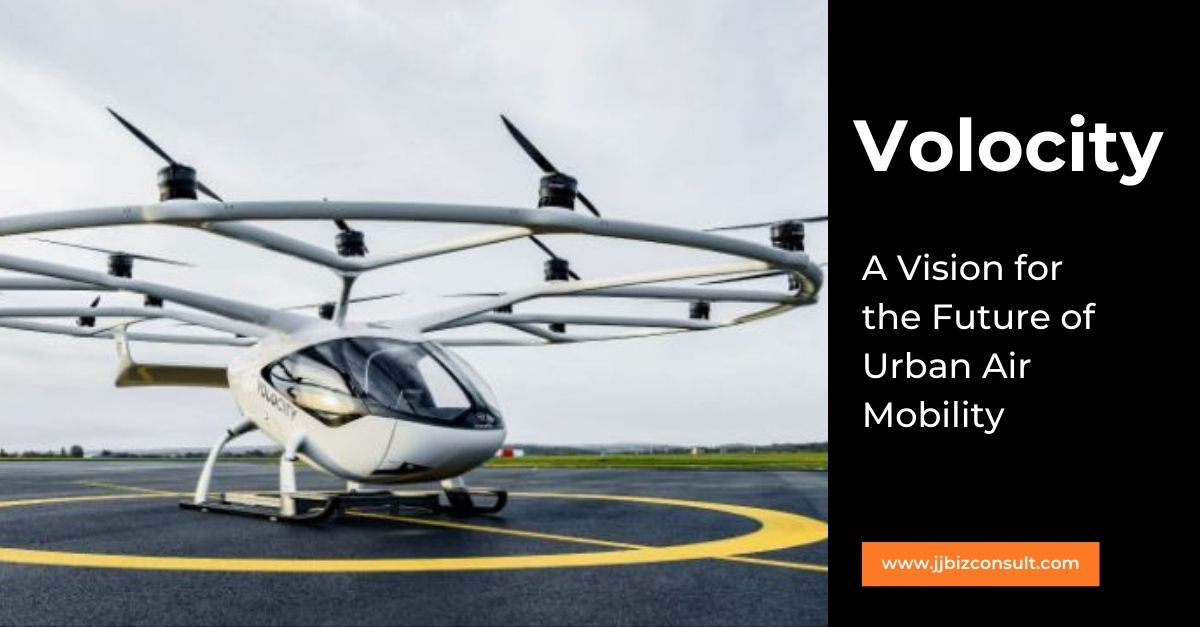
Volocity: A Vision for the Future of Urban Air Mobility
Volocity, a pioneering electric vertical take-off and landing (VTOL) aircraft developed by Volocopter, is poised to revolutionize urban transportation. With its innovative design and advanced technology, Volocity offers a glimpse into the future of air mobility.
Volocity: A Closer Look at Its Design and Features
Volocity’s sleek and futuristic design incorporates 18 rotors, providing the necessary lift and propulsion for vertical takeoffs and landings. These rotors are arranged in a unique configuration that ensures stability and maneuverability.
Volocopter VoloCity: Detailed Overview
- Design and Technology:
- All-Electric Propulsion: The VoloCity is powered by 18 electric motors, ensuring it is a zero-emission aircraft. This makes it environmentally friendly and aligns with global sustainability goals.
- Autonomous Flight: Equipped with advanced sensors and artificial intelligence, the VoloCity can operate autonomously. This technology enhances safety and efficiency, reducing the need for human intervention.
- Redundancy Systems: To ensure passenger safety, the VoloCity features multiple redundant systems for critical components. This means that if one system fails, others can take over, minimizing the risk of accidents.
- Passenger Comfort: The aircraft offers a spacious cabin with panoramic views, providing a comfortable and enjoyable experience for passengers.
The Future of Urban Transportation with Volocity

Volocity is designed to operate in dense urban areas, providing a fast and efficient alternative to traditional ground transportation. By reducing traffic congestion and improving accessibility, Volocity can contribute to a more sustainable and livable city.
Benefits of Volocity:
- Reduced congestion: It can help alleviate traffic congestion on roads and highways.
- Improved accessibility: It can connect remote areas to city centers, improving accessibility for residents and tourists.
- Reduced emissions: As an electric VTOL aircraft, It produces zero emissions, contributing to a cleaner environment.
- Faster travel times: Volocity can significantly reduce travel times, especially during peak hours.
Challenges and Opportunities
While the potential benefits of Volocity and other VTOL aircraft are significant, there are also challenges to overcome. These include regulatory hurdles, infrastructure requirements, and public acceptance. However, with continued innovation and collaboration between industry, government, and society, these challenges can be addressed.
How does the VoloCity compare to other flying taxis?
The VoloCity stands out in the emerging market of flying taxis due to several unique features and design choices. Here’s a comparison with some other notable flying taxi models:
VoloCity vs. Other Flying Taxis
**1. Lilium Jet:
- Propulsion: The Lilium Jet uses ducted electric jet engines, while the VoloCity relies on 18 rotors for lift and propulsion.
- Range and Speed: The Lilium Jet boasts a longer range (up to 300 km) and higher speed (up to 300 km/h) compared to the VoloCity, which is designed for shorter urban trips.
- Passenger Capacity: The Lilium Jet can carry up to 5 passengers, whereas the VoloCity is designed for 2 passengers.
**2. Joby Aviation:
- Propulsion: Joby’s aircraft uses tilt-rotor technology, allowing for efficient vertical takeoff and horizontal flight. The VoloCity’s fixed rotor design focuses on stability and maneuverability in urban environments.
- Range and Speed: Joby’s aircraft has a range of around 240 km and a top speed of 320 km/h, making it suitable for longer commutes.
- Passenger Capacity: Joby’s aircraft can accommodate up to 4 passengers, offering more capacity than the VoloCity.
**3. EHang 216:
- Propulsion: The EHang 216 uses a similar multi-rotor design with 16 rotors, providing redundancy and safety.
- Autonomy: Both the EHang 216 and VoloCity are designed for autonomous flight, but EHang has been more aggressive in pursuing autonomous operations in various cities.
- Passenger Capacity: The EHang 216, like the VoloCity, is designed for 2 passengers.
Key Differentiators of VoloCity:
- Urban Focus: It is specifically designed for short, urban trips, making it highly maneuverable and suitable for dense city environments.
- Safety and Redundancy: With 18 rotors and multiple redundant systems, the VoloCity prioritizes passenger safety.
- Sustainability: As an all-electric aircraft, the VoloCity contributes to reducing urban emissions and aligns with global sustainability goals.
Each flying taxi model has its strengths and is designed with specific use cases in mind. The VoloCity excels in urban environments with its focus on safety, maneuverability, and sustainability. In contrast, models like the Lilium Jet and Joby Aviation’s aircraft offer longer ranges and higher speeds, making them suitable for intercity travel.
Safety Features
It is designed with a strong emphasis on safety, incorporating multiple advanced features to ensure passenger security and reliability. Here are some key safety aspects:
Redundancy Systems
- Multiple Redundant Systems: The VoloCity features redundancy in all critical systems, including rotors, electric motors, batteries, avionics, and displays. Each of these components has at least two backups. This means that if one system fails, others can take over, significantly reducing the risk of accidents.
Advanced Sensors and AI
- Autonomous Flight Capabilities: Equipped with advanced sensors and artificial intelligence, It can operate autonomously. These systems continuously monitor the aircraft’s performance and surroundings, enabling real-time adjustments to ensure safe flight operations.
Safety Standards and Certification
- EASA Certification: The VoloCity is designed to meet the stringent safety standards set by the European Union Aviation Safety Agency (EASA). This includes compliance with the SC-VTOL (Special Condition for Vertical Take-Off and Landing) category enhanced specifications2.
Passenger Safety Features
- Stable and Controlled Flight: The aircraft’s design, including its 18 rotors, ensures stability and maneuverability, even in urban environments. This stability is crucial for safe takeoffs, landings, and overall flight operations.
- Comfortable and Secure Cabin: The passenger cabin is designed to provide a safe and comfortable experience, with features like secure seating and panoramic views to enhance the overall journey.
Noise Reduction
- Low Noise Signature: It operates at a noise level that is four times quieter than a small helicopter. This not only makes it more pleasant for passengers but also reduces noise pollution in urban areas.
Extensive Testing
- Proven Track Record: It has undergone over 1,000 test flights, incorporating feedback and data from these tests to continuously improve safety and performance. This extensive testing ensures that the aircraft is reliable and ready for commercial operations.
Emergency Systems
- Emergency Procedures: It is equipped with emergency systems and procedures to handle unexpected situations. These include automated emergency landing capabilities and communication systems to alert ground control in case of any issues.
How does VoloCity handle adverse weather conditions?
The VoloCity is designed to handle a variety of weather conditions, ensuring safety and reliability even in less-than-ideal circumstances. Here are some key aspects of how it manages adverse weather:
Weather Resilience Features
**1. Advanced Sensors and AI:
- The VoloCity is equipped with advanced sensors and artificial intelligence that continuously monitor weather conditions. These systems can detect and respond to changes in weather, adjusting flight paths and operations as needed to maintain safety.
**2. Redundant Systems:
- The aircraft’s multiple redundant systems ensure that even if one component fails due to adverse weather, others can take over. This includes redundant navigation and communication systems that are crucial during poor visibility or turbulent conditions.
**3. Flight Control Systems:
- The VoloCity’s flight control systems are designed to handle turbulence and wind shear, which are common in adverse weather. These systems help maintain stability and control, ensuring a smooth flight experience.
Operational Strategies
**1. Pre-Flight Weather Assessments:
- Before each flight, comprehensive weather assessments are conducted to determine the feasibility of the flight. If severe weather is predicted, flights can be rescheduled or rerouted to ensure passenger safety.
**2. Real-Time Weather Updates:
- During flight, the VoloCity receives real-time weather updates, allowing it to make necessary adjustments. This includes avoiding areas with severe weather such as thunderstorms or heavy rain1.
**3. Emergency Protocols:
- In case of sudden adverse weather conditions, the VoloCity is equipped with emergency protocols, including automated emergency landing capabilities. These protocols ensure that the aircraft can safely land at the nearest suitable location.
Design Considerations
**1. Aerodynamic Design:
- The VoloCity’s aerodynamic design helps it withstand strong winds and turbulence. Its 18-rotor configuration provides stability and control, which are essential in adverse weather conditions.
**2. Noise Reduction:
The VoloCity’s combination of advanced technology, robust design, and strategic operational protocols ensures that it can handle a wide range of weather conditions safely. While severe weather can still pose challenges, the VoloCity is well-equipped to manage these situations, prioritizing passenger safety and comfort.
How does VoloCity handle lightning strikes?
The VoloCity is designed with several safety features to handle lightning strikes and ensure passenger safety. Here are some key aspects:
Lightning Protection Systems
**1. Electromagnetic Shielding:
- The VoloCity is equipped with electromagnetic shielding to protect its electronic systems from lightning-induced surges. This shielding helps prevent damage to critical components and ensures the aircraft’s systems remain operational during and after a lightning strike.
**2. Conductive Materials:
- The aircraft’s structure incorporates conductive materials that help dissipate the electrical energy from a lightning strike. This design ensures that the energy is safely directed away from critical systems and passengers.
Redundancy and Safety Systems
**1. Redundant Systems:
- The VoloCity features multiple redundant systems for all critical components, including avionics and power systems. This redundancy ensures that if one system is affected by a lightning strike, backup systems can take over, maintaining the aircraft’s functionality.
**2. Advanced Sensors and AI:
- The aircraft’s advanced sensors and artificial intelligence continuously monitor weather conditions, including the presence of lightning. These systems can adjust flight paths and operations to avoid areas with high lightning activity.
Testing and Certification
**1. Rigorous Testing:
- The VoloCity has undergone extensive testing, including simulations and real-world scenarios, to ensure it can withstand lightning strikes. These tests are part of the certification process to meet the stringent safety standards set by aviation authorities.
**2. EASA Certification:
- The VoloCity is designed to comply with the European Union Aviation Safety Agency (EASA) standards, which include requirements for lightning protection. This certification ensures that the aircraft meets high safety standards for operating in various weather conditions.
Operational Protocols
**1. Pre-Flight Weather Assessments:
- Before each flight, comprehensive weather assessments are conducted to identify potential lightning activity. If lightning is detected in the flight path, the flight can be rescheduled or rerouted to ensure safety.
**2. Emergency Procedures:
- The VoloCity is equipped with emergency procedures to handle unexpected lightning strikes. These include automated systems that can safely land the aircraft if necessary.
The VoloCity’s design and safety features ensure that it can handle lightning strikes effectively, protecting both the aircraft and its passengers. With advanced technology, rigorous testing, and compliance with safety standards, the VoloCity is well-prepared to operate safely in various weather conditions.
Conclusion
Volocity represents a significant step forward in the development of urban air mobility. With its advanced technology, innovative design, and commitment to sustainability, Volocopter is paving the way for a new era of transportation. As Volocity and other VTOL aircraft continue to evolve, we can expect to see a transformative impact on urban living.
Lilium Takes Off: eVTOL Aircraft Powers Up for First Flight
Joby eVTOL Triumph: Exciting Delivery to the U.S. Air Force
eVTOL – Archer Aviation hope to deliver 250 Sensational air taxis





